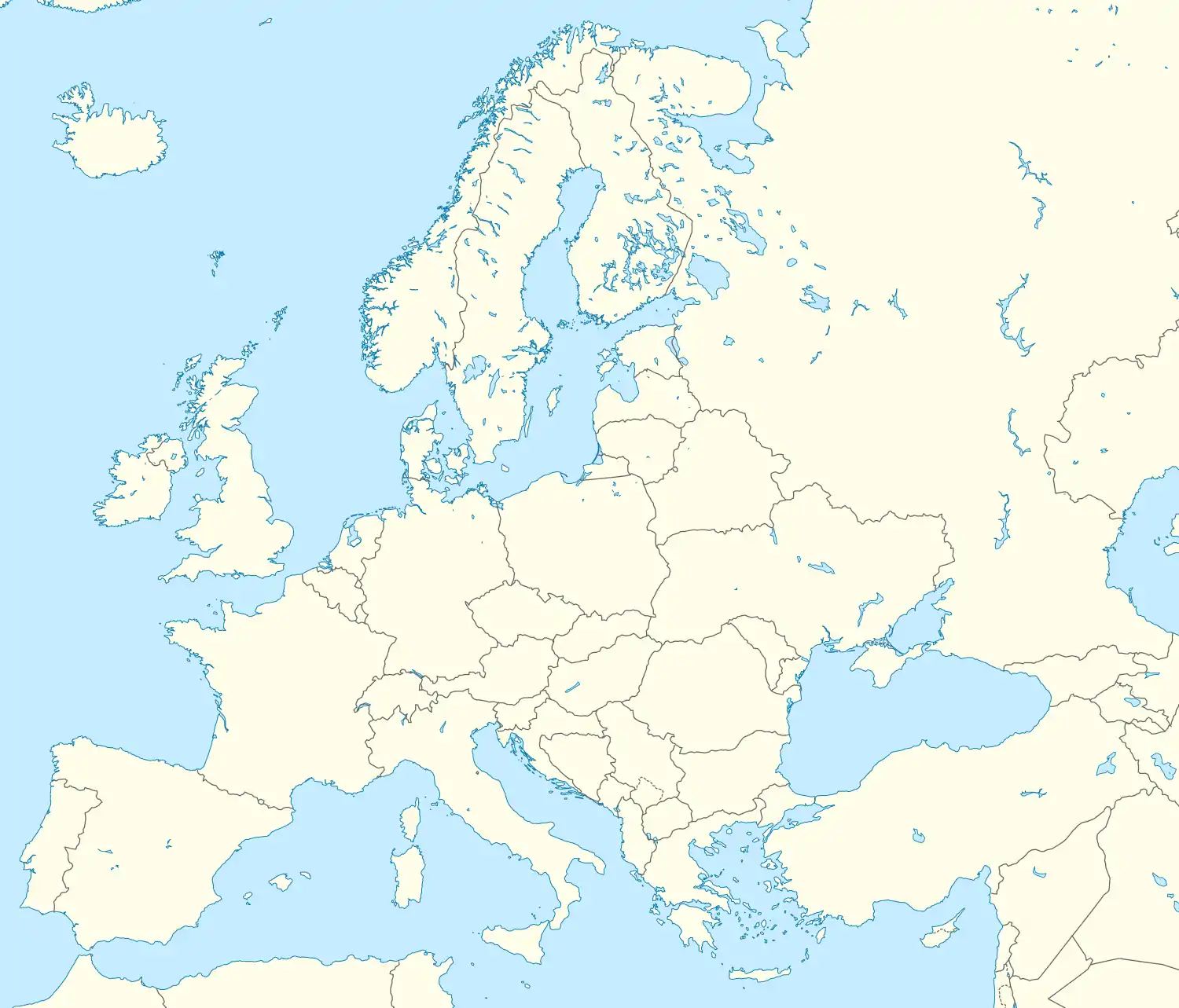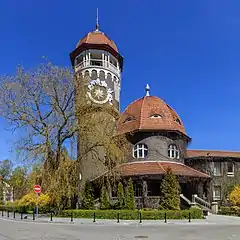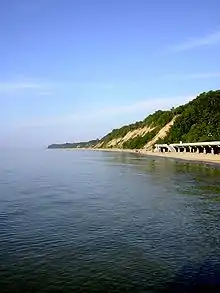Svetlogorsk, Kaliningrad Oblast
Svetlogorsk (Russian: ![]() Светлого́рск ), prior to 1947 known by its German name Rauschen (Polish: Ruszowice; Lithuanian: Raušiai)), is a coastal resort town and the administrative center of Svetlogorsky District of Kaliningrad Oblast, Russia, located on the coast of the Baltic Sea on the Sambia Peninsula, 39 kilometers (24 mi) northwest of Kaliningrad. Population figures: 10,772 (2010 Census);[3] 10,950 (2002 Census);[8] 11,881 (1989 Census).[9]
Светлого́рск ), prior to 1947 known by its German name Rauschen (Polish: Ruszowice; Lithuanian: Raušiai)), is a coastal resort town and the administrative center of Svetlogorsky District of Kaliningrad Oblast, Russia, located on the coast of the Baltic Sea on the Sambia Peninsula, 39 kilometers (24 mi) northwest of Kaliningrad. Population figures: 10,772 (2010 Census);[3] 10,950 (2002 Census);[8] 11,881 (1989 Census).[9]
Svetlogorsk
Светлогорск | |
|---|---|
Town[1] | |
.JPG.webp) View of Svetlogorsk | |
.png.webp) Flag .png.webp) Coat of arms | |
Location of Svetlogorsk 
| |
 Svetlogorsk Location of Svetlogorsk .svg.png.webp) Svetlogorsk Svetlogorsk (European Russia)  Svetlogorsk Svetlogorsk (Europe) | |
| Coordinates: 54°57′N 20°09′E | |
| Country | Russia |
| Federal subject | Kaliningrad Oblast[1] |
| Administrative district | Svetlogorsky District[1] |
| Town of district significance | Svetlogorsk[1] |
| Founded | 1258[2] |
| Elevation | 40 m (130 ft) |
| Population | |
| • Total | 10,772 |
| • Estimate (2018)[4] | 13,663 (+26.8%) |
| • Capital of | Svetlogorsky District[1], town of district significance of Svetlogorsk[1] |
| • Municipal district | Svetlogorsky Municipal District[5] |
| • Urban settlement | Svetlogorskoye Urban Settlement[5] |
| • Capital of | Svetlogorsky Municipal District[5], Svetlogorskoye Urban Settlement[5] |
| Time zone | UTC+2 (MSK–1 |
| Postal code(s)[7] | 238560, 238561, 238563 |
| OKTMO ID | 27634101001 |
| Website | www |
History
Svetlogorsk is situated in the historical region of Sambia of East Prussia. It was established in 1258[2] as a Sambian fishermen settlement named Ruse-moter (lit. region of cellars). The Teutonic Order that conquered the land gradually corrupted the name into Rause-moter, Raushe-moter, and finally Rauschen. The order brothers set a new direction for the life of the village: they blocked off the Katzenbach stream, which flows into the lake, and installed a mill on the stream. From that time on, the lake became known as Mühlen-taich (Mill Pond), and the mill business became the main one for the inhabitants of the village. During the Order's times it was the largest mill on Samland.

In the early 19th century, the place became fashionable among German vacationers. Since access to the sea was hampered by a sand dune, the picturesque corners of the lake were the place of residence and recreation. A tavern was opened near the mill, new villas and boarding houses were built. On June 24, 1820, it was officially recognized as a spa town. During his visit to Rauschen in 1840, King Frederick William IV of Prussia ordered the sea embankment to be beautified. The popularity of the city as a resort has grown significantly since 1900, when a railway was built from Königsberg to Rauschen / Orth station, extended in 1906 to Rauschen / Dune station. Trains were now able to drive closer to the sea, and the resort became much more accessible for many residents of Königsberg. A positive role both in the development of the resort and in attracting tourists was played by the hippodrome opened in Rauschen by the equestrian society. The city began to divide into two parts: the lower one - near the lake, and the upper one (40-50 m higher) by the sea. The upper village was located approximately at an altitude of up to 60 m above sea level, so a pleasant event in his life was the opening in 1912 of a funicular - a 90-meter inclined railroad to deliver holidaymakers to the sea and back. The arrangement of the resort could not do without the arrangement of beach areas. In 1908, a wooden promenade-promenade deck was built on the seashore on stilts, several serpentine descents led to it. Otto Nicolai, Wilhelm von Humboldt, Käthe Kollwitz and Thomas Mann were among the celebrities who stayed there. In the early years of the 20th century, private individuals launched an intensive construction of country houses, villas, boarding houses in Rauschen, especially in the upper part of the resort.
In 14 April 1945, Rauschen was conquered by the Soviet Union in the course of World War II. It became a part of Kaliningrad Oblast and in 17 June 1947 was given its present name.[2] Today, it is a moderately popular summer resort town thanks to its beachfront and many spas, clubs, and attractions. It has arguably the best preserved Prussian heritage and architecture amongst former Soviet towns that were once Prussian and survived the destruction of Konigsberg and other settlements from WWII.

Administrative and municipal status
Within the framework of administrative divisions, Svetlogorsk serves as the administrative center of Svetlogorsky District.[1] As an administrative division, it is incorporated within Svetlogorsky District as the town of district significance of Svetlogorsk.[1] As a municipal division, the town of district significance of Svetlogorsk is incorporated within Svetlogorsky Municipal District as Svetlogorskoye Urban Settlement.[5]
Transportation
Svetlogorsk is connected with Kaliningrad, Zelenogradsk, and Pionersky by electrified railway (3000 V DC). Svetlogorsk has two railway stations: Svetlogorsk-1 and Svetlogorsk-2 (terminus).
There are many private companies that operate buses between Svetlogorsk and Kaliningrad.
References
Notes
- Resolution #640
- Энциклопедия Города России. Moscow: Большая Российская Энциклопедия. 2003. p. 413. ISBN 5-7107-7399-9.
- Russian Federal State Statistics Service (2011). "Всероссийская перепись населения 2010 года. Том 1" [2010 All-Russian Population Census, vol. 1]. Всероссийская перепись населения 2010 года [2010 All-Russia Population Census] (in Russian). Federal State Statistics Service.
- "26. Численность постоянного населения Российской Федерации по муниципальным образованиям на 1 января 2018 года". Federal State Statistics Service. Retrieved January 23, 2019.
- Law #182
- "Об исчислении времени". Официальный интернет-портал правовой информации (in Russian). June 3, 2011. Retrieved January 19, 2019.
- Почта России. Информационно-вычислительный центр ОАСУ РПО. (Russian Post). Поиск объектов почтовой связи (Postal Objects Search) (in Russian)
- Russian Federal State Statistics Service (May 21, 2004). "Численность населения России, субъектов Российской Федерации в составе федеральных округов, районов, городских поселений, сельских населённых пунктов – районных центров и сельских населённых пунктов с населением 3 тысячи и более человек" [Population of Russia, Its Federal Districts, Federal Subjects, Districts, Urban Localities, Rural Localities—Administrative Centers, and Rural Localities with Population of Over 3,000] (XLS). Всероссийская перепись населения 2002 года [All-Russia Population Census of 2002] (in Russian).
- "Всесоюзная перепись населения 1989 г. Численность наличного населения союзных и автономных республик, автономных областей и округов, краёв, областей, районов, городских поселений и сёл-райцентров" [All Union Population Census of 1989: Present Population of Union and Autonomous Republics, Autonomous Oblasts and Okrugs, Krais, Oblasts, Districts, Urban Settlements, and Villages Serving as District Administrative Centers]. Всесоюзная перепись населения 1989 года [All-Union Population Census of 1989] (in Russian). Институт демографии Национального исследовательского университета: Высшая школа экономики [Institute of Demography at the National Research University: Higher School of Economics]. 1989 – via Demoscope Weekly.
Sources
- Правительство Калининградской области. Постановление №640 от 30 августа 2011 г. «Об утверждении реестра объектов административно-территориального деления Калининградской области», в ред. Постановления №877 от 21 ноября 2011 г «О внесении изменения в Постановление Правительства Калининградской области от 30 августа 2011 г. №640». Вступил в силу со дня официального опубликования. Опубликован: "Калининградская правда" (вкладыш "Официально"), №170, 15 сентября 2011 г. (Government of Kaliningrad Oblast. Resolution #640 of August 30, 2011 On the Adoption of the Registry of the Objects of the Administrative-Territorial Divisions of Kaliningrad Oblast, as amended by the Resolution #877 of November 21, 2011 On Amending the Resolution of the Government of Kaliningrad Oblast #640 of August 30, 2011. Effective as of the day of the official publication.).
- Калининградская областная Дума. Закон №182 от 2 ноября 2007 г. «Об организации местного самоуправления на территории Светлогорского городского округа», в ред. Закона №343 от 6 октября 2014 г. «О внесении изменений в отдельные законодательные акты Калининградской области». Вступил в силу со дня официального опубликования. Опубликован: "Калининградская правда", №209, 7 ноября 2007 г. (Kaliningrad Oblast Duma. Law #182 of November 2, 2007 On the Organization of the Local Self-Government on the Territory of Svetlogorsky Urban Okrug, as amended by the Law #343 of October 6, 2014 On Amending Various Legislative Acts of Kaliningrad Oblast. Effective as of the day of the official publication.).